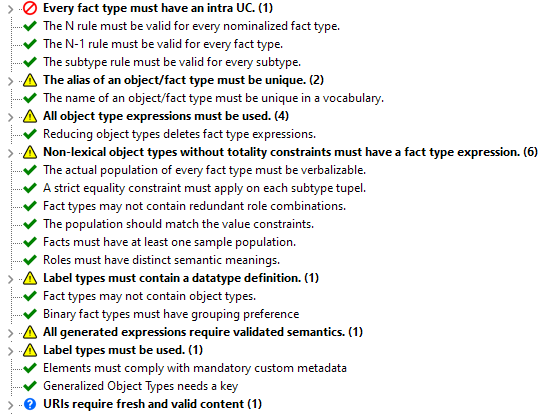|
|
| (70 intermediate revisions by the same user not shown) |
| Line 1: |
Line 1: |
| = Every fact type must have an intra UC = | | = Model Well-formedness = |
| For each fact type, there must be at least one uniqueness constraint that concerns one or more roles of this fact type only.
| | This window shows the well-formedness rules for the active model. This window shows the basic rules to which your model should comply. It shows both errors and warnings. Errors need to be solved before any model generation can be started. Warnings are optional and are indicators to the modeler where to potentially improve the model. |
|
| |
|
| = The N rule must be valid for every nominalized fact type =
| | It is advised to perform these rule checks regularly to keep the model in order. |
| Every nominalized fact type with n roles only has exactly one uniqueness constraint over all n roles.
| |
|
| |
|
| = The N-1 rule must be valid for every fact type =
| | [[File:ModelWellFormedness9.png]] |
| If a fact type with n roles has at least one uniqueness constraint on less than n-1 roles, then the fact type is splittable. The n-1 rule-test simply consists of the check that there are no UCs that are too small.
| |
|
| |
|
| = The subtype rule must be valid for every subtype =
| | The disablement of rules is saved inside the current project settings. |
| * There can be no single role totality constraint on the role of a unary fact type.
| |
| * Each derivable subtype must have a derivation rule, in which only roles can occur (apart from the role of the subtype itself) from fact types that
| |
| ** either are played by one or more of its supertypes
| |
| ** or are found in one or more of its supertypes
| |
| * In a fact type that is a subtype, all roles have a single role uniqueness constraint. For nominalized subtypes, all object type expressions concern exactly one role.
| |
|
| |
|
| =The alias of an object/fact type must be unique.= | | = Full List = |
|
| |
|
| = All object type expressions must be used =
| | Click here for a full list of validation rules and their description: [[Modeler:12/RepositoryRules|Integrity Checks]]. |
| Object type expressions are to be used as part of another and finally in an Fact type expression. If no substitution is found for an object type expression, it is found to be invalid.
| |
| | |
| = Non-lexical object types without totality constraints must have a fact type expression =
| |
| If no totality constraint at all applies to any of the roles played by a certain nominalized fact type, then that fact type must have an existence postulating fact type expression.
| |
| | |
| =The actual population of every fact type must be verbalizable.=
| |
| | |
| =A strict equality constraint must apply on each subtype tupel.=
| |
| | |
| = Fact types may not contain redundant role combinations =
| |
| | |
| =The population should match the value constraints.=
| |
| | |
| =The population should match the totality constraints.=
| |
| | |
| =Facts must have at least one sample population.=
| |
| | |
| =Roles must have distinct semantic meanings.=
| |
| | |
| =Label types must contain a datatype definition.=
| |
| | |
| = Fact types may not contain object types =
| |
| Fact types with n roles, and n > 2, with a single UC covering N-1 roles, these roles under the UC may be candidate for nominalization.
| |
| | |
| = Binary fact types must have grouping preference =
| |
| Binary fact types where both roles are under a single uc, or both roles under their own uc, this fact type cannot be automatically grouped during transformation. Therefor to be optimized, at least one role needs a grouping preference.
| |
| | |
| = All generated expressions require validated semantics =
| |
| In later version of CaseTalk more model (re)factoring functions exist. This may lead to default generated expressions, which are not manually entered by an analyst. To guarantee model quality, these need to be manually verified.
| |
| | |
| =Label types must be used.=
| |
| | |
| =Populations must comply with uniqueness constraints=
| |
| | |
| =Populations must comply with totality constraints (11)=
| |
| | |
| =Population must comply with subset constraints=
| |
| | |
| =Population must comply with datatype=
| |
| | |
| =External expressions must be supported=
| |
| | |
| =External namespace must cover one version=
| |
| | |
| =ValueConstraints must comply with datatype=
| |
| | |
| =Expression requires soft semantics=
| |
|
| |
|
| ---- | | ---- |
|
| |
|
| Back: [[:Modeler:Tutorial/Subtype and Generalisation|Subtype and Generalisation]] | | Back: [[:Modeler:Tutorial/Subtype and Generalisation|Subtype and Generalisation]] |
|
| | |
| [[Category:Modeler]] | | Next: [[:Modeler:Tutorial/Version Management|Version Management]] |
